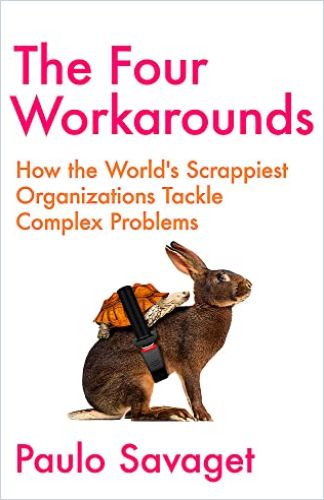When the going gets tough, bold and creative organizations and individuals get the job done anyway. Innovation and entrepreneurship researcher Paulo Savaget explains exactly how these “scrappy” people and companies solve knotty problems, accomplish goals in challenging circumstances, and often, subvert the status quo in the process.

Complex Problems, Subversive Solutions
As today’s business environment becomes ever more complex and unpredictable, conventional approaches often flounder. But some organizations and individuals find a way forward by discarding proven tactics and processes and, instead, pivoting to innovative, sometimes experimental solutions. Small organizations, underfunded nonprofits, start-ups, and individual operators often succeed only because they embrace unconventional methods, mainly out of necessity. But big corporations can resort to creative, resourceful strategies, too, when pressing issues or unique circumstances demand a quick, innovative response.
Simply following or breaking rules isn’t always the best way to get something done. Often there is an option that lies in between. Paulo Savaget
Paulo Savaget, who works in both the Department of Engineering Science and the Saïd Business School at the University of Oxford, conducts research in entrepreneurship, sustainable development, systems change, and innovation management. He focuses on the transformation of unjust systems through entrepreneurship. He’s been studying bold, resourceful — or “scrappy” — problem solvers for years.
Savaget’s eye-opening, inspiring book describes the strategies and tactics of scrappy people and organizations, offering illustrations from a variety of sectors, industries, and locales — as well as insights into the mindsets that enable them to break, bend, subvert, or skirt rules and conventional wisdom when the situation calls for it.
Take Four Ways Around — or Through
Savaget found that scrappy organizations and individuals use four categories of workarounds to bypass entrenched problem-solving approaches and devise innovative solutions, depending on the specific relationships, opportunities, restrictions, and time constraints of the situation.
In a “piggyback” workaround, Savaget’s first category, you build on the established relationships or structures in an existing system. When conventional methods fail or an organization is short of funds or resources, piggybacking can offer an unexpected solution. For example, he cites the case of British social entrepreneurs Jane and Simon Berry, who found a way to get a remedy for diarrhea to children across impoverished African countries: They noticed that Coca-Cola was available in even the most remote hamlets on Earth. So they piggybacked on Coca-Cola’s distribution system by inserting a package of children’s diarrhea medicine in its shipping crates.
Coming up with workarounds is more like playing with Legos than completing a puzzle: You have building blocks, and your challenge is to build something.Paulo Savaget
In “loophole” workarounds, Savaget’s second category, you exploit ambiguity or use alternative rules to create opportunities beyond the status quo. Savaget recommends considering this kind of workaround when your options are limited by restrictive rules. This might sound shady, but Savaget points out that rules and restrictions are often unjust or undesirable, and the loophole approach offers creative ways to achieve worthy goals in legal, albeit unconventional, ways. For example, during the 1940s, 1950s, and 1960s, Americans who found it difficult to obtain a divorce at home traveled to Mexico, which offered simple, no-nonsense divorces to foreigners. Celebrities like Elizabeth Taylor and Marilyn Monroe untied the knot this way, as did some half a million other unhappily married American couples.
“Roundabout” workarounds, Savaget’s third category, are a bit more difficult to define, but they’re easy to spot: Where an entrenched behavior or custom is hampering progress, someone finds a way to break the negative cycle and create room for a solution or a shift in the status quo. Savaget offers an illustration from India, where public urination has been a long-standing problem. After many direct efforts to stem the problem failed, one clever property owner began to install ceramic tiles depicting Hindu gods on the walls around knee height. Because many Indian people believe urinating on or before a god is blasphemous, the behavior stopped. Soon, the ceramic tiles were appearing everywhere.
Savaget’s fourth category, “next-best” workarounds, can help in situations where you’re tackling a large, complex problem, and time, labor, or other resources are in short supply. Next-best workarounds often recombine existing equipment and systems or spot opportunities others haven’t considered, Savaget says. For example, travelers often encounter problems using electronics abroad because countries use different wall plugs. Changing infrastructure globally to adopt a universal standard would be ideal but impractical. Instead, simple, inexpensive travel adapters — a next-best solution — get the job done.
Bend the Rules — Ethically
Using workarounds often means bending, breaking, or bypassing rules — or at least the way people usually do things. If this makes you uncomfortable, Savaget suggests you consider the perspective that rules and conformity don’t always serve the greater good. Rules often function as tools of the powerful, he says, benefiting those in authority and delegitimizing those who might pose a threat.
Soberingly, he points out that conformity can lead to atrocities if people fail to question and resist harmful rules and norms. For Savaget, motivation matters: Simply flaunting rules is one thing, but taking an unconventional approach that involves critical thinking and innovative problem-solving is another.
Explore and Experiment
Savaget points out that conventional decision-making and problem-solving typically involve methodical and thorough analysis, linear processes, and a reliance on expert knowledge and experience. But when you’re seeking unconventional approaches, he says, you’ll need to take a different tack. He recommends loosening up your analysis to allow room for ambiguity, shifting your attention to notice what you don’t know, and questioning your assumptions.
We are better off appreciating and exploring ‘known unknowns’ than fixating on the little that we do know.Paulo Savaget
Anyone can develop the “constructive nonconformist” mindset that underlies the use of workarounds, Savaget promises. Tackle challenges from new angles, or change your focus or framing, much as a photographer would, he advises. Or apply knowledge from one area to solve a problem in another. Established business practices and norms can be unfriendly to the workaround mindset, Savaget acknowledges. To facilitate flexible, creative, and out-of-the-box thinking in your organization, he advises encouraging people to explore and experiment rather than engage in exhaustive planning. Support collaborative sharing of ideas, and be open to pivoting.














